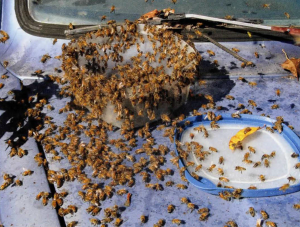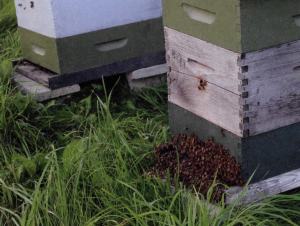By: Ross Conrad
This article originally appeared in the Autumn 2016 issue of BEEKeeping Your First Three Years
Honey bee workers normally forage for nectar and pollen from flowers which are brought back to the hive and converted into honey and bee bread. Unfortunately, foragers can also seek to obtain a quick payload by seeking out anything sweet they can find, even to the point of ransacking another colony. Such foraging activity known as robbing, can spread disease, cause colonies to become abnormally aggressive and defensive, make queen introduction more difficult, and working with colonies unpleasant. In extreme cases robbing can cause a colony to starve to death due to the loss of all honey stored within the hive.
What causes the fall from grace?
For one reason or another, foraging bees tend not to be very interested in robbing or even going after exposed honey when natural nectar sources are plentiful. Thus, a dearth of nectar is a primary trigger that leads to robbing behavior. Especially vulnerable are weak hives whose populations are low, such as newly hived packages and nucleus colonies, queenless hives, or hives suffering from a mite overload and/or disease. Such colonies may not have enough guard bees to protect the entrance(s) to the hive adequately. If the hive entrance is too large an opening, or if there are too many entrances, even a strong hive may have trouble protecting itself and keeping robbers at bay.
Feeding colonies from open containers can also cause robbing among hives. Worker bees dancing to recruit additional foragers to a food source close to the hive will communicate using a circular dance. During the dance, the worker will occasionally stop and offer a taste of the food that has been gathered to prospective foragers that are following the dance within the hive. When the food source tastes and smells like honey, or has little to no scent as in the case of sugar syrup, then any other hive located within about a hundred yards of the colony will become a target for the foragers. Even when a feeding stimulant is added to the sugar syrup in a bulk feeder to endow the feed with a unique scent, other colonies will become the target of robbers as the foragers from those colonies bring in the scented feed and make their hives smell like the food source. The same is true for any feed or honey that is spilled or left exposed in or around the beeyard.
The boardman entrance feeder that fits in the bottom opening of a standard Langstroth hive and is often sold as part of a beginner’s kit, is notorious for precipitating robbing behavior from neighboring colonies. This feeder, located so close to the hive entrance, is difficult for a colony to protect from robbers especially when the daytime temperature cools down and many bees are needed to maintain the warmth of the brood nest.
Tips for recognizing and catching robbers red-handed
One sign that robbing may be occurring in your hives is the presence of dead bees laying about in front of the hive or on the inner cover when the outer cover is removed. These carcasses are the remains of robbers that were caught stealing from the hive and guard bees that died defending their nest. Another telltale sign of robbing are the remains of cappings torn from the combs as the robbing bees worked to get the loot and get out of there as quickly as possible. As a result, the cells of the empty combs from hives that have had their honey stores robbed out will be ragged looking since the robbers don’t take the time to remove the cappings neatly.
Colonies that have been the target of robbing will be more defensive than normal. Guard bees will be aggressive and will tend to closely inspect all foragers upon their return. Robber bees that are challenged in this way will be quick to take to the wing, flying around the hive waiting for another chance to try and enter. This should not however be confused with bees that are hovering around the front of the hive as they leave the colony to take their first flights. This is where your ability to notice the fine details of honey bee body language and behavior comes in handy. Bees on their maiden flights will be facing the hive entrance, smoothly and purposely flying back and forth as they orient themselves to their colony’s appearance and location. Robber bees by contrast will tend to act more like they don’t belong there, flying in irregular patterns around the hive, darting to-and-fro looking for a chance to slip past the guards. Foraging workers with the intent of robbing can be seen inspecting cracks in the hive and places on the hive that are in stark contrast to the color of the hive, such as knots in the hive’s wooden exterior, as they seek out a way inside that is not well guarded.
To the beginner’s eye, a hive being robbed out can seem normal due to the abundance of bee activity around the entrance. It is upon opening such a hive that the signs of robbing activity become more obvious. Rather than stay in the hive and on the combs, robber bees will act nervously, abandoning the combs and taking to the air as soon as the hive is opened. Upon opening up a queenright hive full of bees that belong there, a high percentage of the bees that immediately take to the air they will typically do so because they are intent on attacking you. Of course if the colony is smoked appropriately, few if any will actually do so. When a hive that is being heavily inundated with robbers is opened up, lots of bees will take to the air, even when smoke has been used, but few of these bees will actually come after you. These robber bees are much more interested in returning to the combs in the hive as soon as you are done disturbing them so they can finish the job they started.
Prevention … the best rehabilitation
As with many hive challenges, keeping healthy, strong colonies with large populations is the best defense. This means dealing with mites and diseases before they become an issue. It is also helpful to match the size of the cavity of the hive with the colony’s population. With bees concentrated on fewer combs, rather than spread thin among many combs, the hive will be easier for the colony to defend.
Reducing entrances down to a single small (approximately one inch) opening can compensate for a hive that lacks enough guard bees to do the job. Equipment that is new or has been well maintained really helps here. Rotten, broken, or cracked supers whose wood is split or warped will need to be repaired or at least caulked or filled with spackling compound, beeswax, or mud.
It also helps to leave your apiary neat and tidy without broken combs, hive scrapings, bee feed, or honey drippings scattered about. Feeders that can be placed inside the hive (such as division board or frame feeders that replace one or more frames within the brood nest, hive top feeders, and feeding pails enclosed within an empty hive body) are preferable to feeding from open containers or entrance feeders. Freshly extracted honey supers, or frames containing bits of honey that you want the bees to clean up should be placed at least 100 yards away from your apiary.
It is far better to work to prevent robbing behavior rather than try to stop it once it has begun. Once it has started, robbing behavior can be very difficult to stop the same day. As a general rule, it is best not to work hives when robbing is prevalent. This is why harvesting honey is much easier and more enjoyable a task when done a little early in the season, before the last of the blossoming plants have lost their flowers and gone dormant in preparation for the Winter season. Unfortunately, despite our best efforts there are going to be those times when working with the bees just can’t wait. When harvesting honey, inspecting, or manipulating hives when robbers are active and could become a problem, work quickly and try not to leave hive open too long, and keep all hive bodies and supers covered as much as possible. Inner covers, outer covers, or a damp cloth can all be used to keep exposed hives and equipment covered up thereby reducing robbing exposure. It is during times like this that one must be extra careful to replace all covers securely and not accidentally leave supers or hive bodies askew creating additional openings for robbers.









